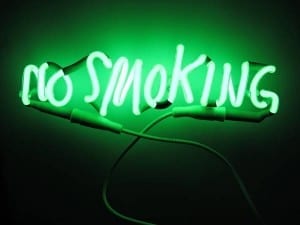Review by Mallory Nanny, a candidate for the MA in Art History at Richmond the American International University in London
Turner Prize winner of 2008, Mark Leckey, currently hosts an exhibition entitled SEE, WE ASSEMBLE, at the Serpentine Gallery until 26 June. Upon entering the first gallery, we are introduced with the main objectives of the exhibition, products of Fiorucci, Henry Moore, and Samsung, as well as how each corresponds with the following stages of time: Past, Past and Present, and Future. Although the artist claims that the former subjects have impacted him in one way or another, he portrays a popular commodity of each in the tradition of advertising; thus bridging the gap between high culture and mass media almost immediately. Leckey incorporates sculpture, sound, film and performance equally throughout the exhibition to give the viewer a particularly unique visual and audio experience in postmodernist art.
Leckey conceptualises the past and present through his “performance” piece entitled Sound Systems, an on-going project since 2001. In the central space of the gallery, a tall bronze sculpture by Henry Moore faces a large stack of speakers, which appear to mimic the sculpture in terms of height and verticality. It seems as if Leckey has purported to match the present with the elegance of the past, as the arrangement of the erected sculptures assume an authoritative presence in the otherwise, empty gallery. The only other piece exhibited is a small poster that functions to inform visitors of the upcoming dates of performances, for the sound art changes week to week. The performance aspect of Sound Systems relies on the sound emanating from the speakers that aims to elicit a response from the Moore sculpture. The sound I experienced was irregular and menacing, reminiscent of the immense roar emitted by furnace/exhaust. It was however, very sporadic, often occurring in fifteen-minute intervals. Between the moments of vibratory clamor were low grumbles and humming that verified its animate existence. While occasionally unpleasant, the inclusion of sound, particularly in relation to the sculpture, achieves a theatrical presence that renders a true sense of chemistry in the communication between past and present.
While its status as a performance piece could be debated, Leckey’s final installation entitled GreenScreenRefrigeratorAction also exhibits aspects of theatricality. The temporary transformation of the gallery into a green screen not only provides a visual connection to the grassy fields of Kensington Gardens, but it also served as the backdrop in the production of the film that is exhibited here on two mounted flat screens. Located between them is the focal point of the work, the black Samsung “smart” refrigerator. Both the fridge and the Samsung name appear almost constantly throughout the film, whether seen against a natural landscape or viewed internally, in a scientifically-charged description that concerns its inner workings. The fridge not only stars in the video, it narrates it as well, in a muffled, robotic voice. The artist has reinvented the concept of the readymade by conveying its animate status in connection to the worldly, and out-of-worldly, environments. While Leckey’s elevation of the object to cult status may be interpreted as wildly propagandistic, it could conversely be interpreted as a commentary on technological advancements, particularly “smart” products which possess the abilities to think and function on their own in correspondence to the needs of its user. Thus not only do we become more dependent on these objects, but we form relationships with them as well. GreenScreenRefrigeratorAction may be understood as Leckey’s prediction of the future of technology in our lives, as well as its effects on the art world.
The installation that best represents the past is most likely an earlier piece from 1999 called Fiorucci Made Me Hardcore, located in the gallery off the right of the entrance. The darkened interior contains a large set of speakers and a video projection that provides a look into the underground UK club scene from the 1970s to the early 1990s. Adding interest to the installation is the soundtrack, which Leckey produced using similar experimental techniques that were popular in the subculture portrayed in the film. There exists, however, a sinister quality in the combined experience of the soundtrack with the grainy quality of the film. Compared to the previously-discussed works which evoke technology, communication and theatricality as common postmodern themes, Fiorucci Made Me Hardcore appears rather detached in the broader scope of the exhibition.
Mark Leckey SEE, WE ASSEMBLE continues until 26 June 2011.
serpentinegallery.org
Aesthetica Magazine
We hope you enjoying reading the Aesthetica Blog, if you want to explore more of the best in contemporary arts and culture you should read us in print too. In the spirit of celebration, Issue 41 includes a piece on Guggenheimn Bilbao where the Luminous Interval features internationally acclaimed artists such as Louise Bourgeois, Kiki Smith and Damien Hirst, ArtAngel’s new commission at MIF, Bruce Nauman’s retrospective at The Kunsthalle Mannheim and Cory Arcangel’s Pro Tools at the Whitney in NYC. You can buy it today by calling +44(0)1904 479 168. Even better, subscribe to Aesthetica and save 20%. Go on, enjoy!
Image:
Mark Leckey
Installation view, Serpentine Gallery, London
(19 May – 26 June 2011)
© 2011 Mark Blower





